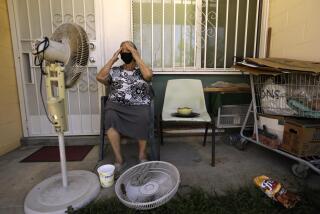Film Blocks Heat, Prevents Fading
- Share via
QUESTION: The afternoon sun shining in our windows literally bakes us and is fading our furniture and carpeting. How effective are the new clear do-it-yourself summer/winter window films?
ANSWER: Window film is your best solution to block heat and fading, especially if you are on a limited budget. The new summer/winter window films save energy year-round as they extend the life of your furniture and carpeting.
Do-it-yourself year-round window film is simple to install. You just need a sharp knife, a spray bottle, soapy water, a squeegee and about 20 minutes.
Window films increase the shatter resistance of glass. In areas prone to tornadoes or hurricanes or children, this is a real plus. Special extra-heavy clear security films make it difficult for burglars to break through.
Each new generation of window film technology reduces the amount of tint needed and increases the life and performance of the film. Some of the new year-round, anti-fade films are so clear that it is difficult to notice them. Some window films carry a 10-year durability warranty.
True summer/winter window films have the same type of low-emissivity (low-e) coatings as new expensive high-tech replacement windows. This blocks heat loss through your windows in the winter and heat gain in the summer. As you apply the film yourself, you can feel the heat reduction immediately.
To achieve these super-efficient properties, a microscopically-thin layer of metal atoms is deposited on the polyester film surface. It is far too thin to see and visible light passes right through it. When this film is applied to the window, the view is distortion-free.
Although most of the window films look similar in the home center store, there are significant differences among them in the summer heat rejection and the winter heat savings. Do not just buy the least expensive.
It is important to compare performance factors for the films. All window films block about 99% of the ultraviolet (UV) rays. Although UV is commonly thought to cause the majority of fading, it actually accounts for only 40% of fading. Heat and light cause a lot of fading too.
Total solar energy rejection (SER) is important when comparing summer performance. Visible light transmission (VLT) compares the glare from the window. Emissivity effects utility bill savings and comfort in the winter.
To block the southern sun around noon, an awning or large roof overhang is effective. Building a window flower box with a shade above is also an attractive option.
Write for Update Bulletin No. 732 showing a buyer’s guide (plus a small sample) of year-round do-it-yourself and professional window films listing SER, emissivity, VLT, tint colors, prices, installation instructions and instructions for making a flower box and shade. Please include $2 and a business-size SASE and mail to James Dulley, Los Angeles Times, 6906 Royalgreen Drive, Cincinnati, OH 45244.
Low-Flow Shower Head Needs Maintenance
Q: I installed a low-flow shower head last year to save water. It worked well at first, but now the shower flow is not forceful enough. What can I do to fix it or should I buy a new one?
A: Most water-saving low-flow shower heads have very tiny holes in the face. These are small to speed up the reduced water flow to provide a more forceful satisfying shower. The holes are probably clogged with deposits.
Remove the shower head and take it apart. Clean out any loose deposits. Soak the plate with the tiny holes overnight in white vinegar. If any deposits remain by morning, poke the holes open with a fine wire.
Letters and questions to Dulley, a Cincinnati-based engineering consultant, may be sent to James Dulley, Los Angeles Times, 6906 Royalgreen Drive, Cincinnati, OH 45244.

